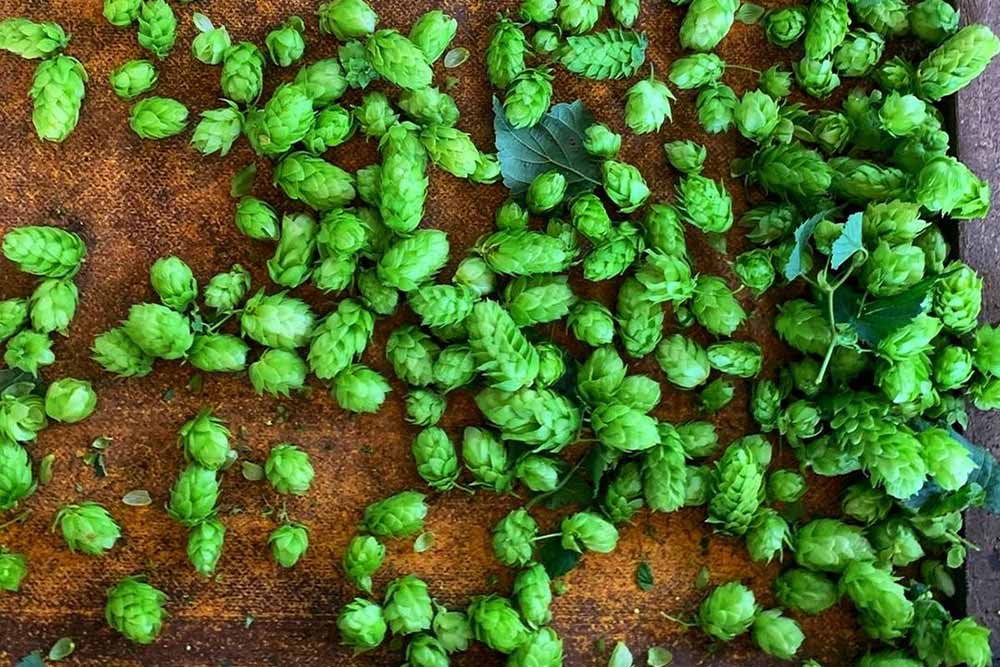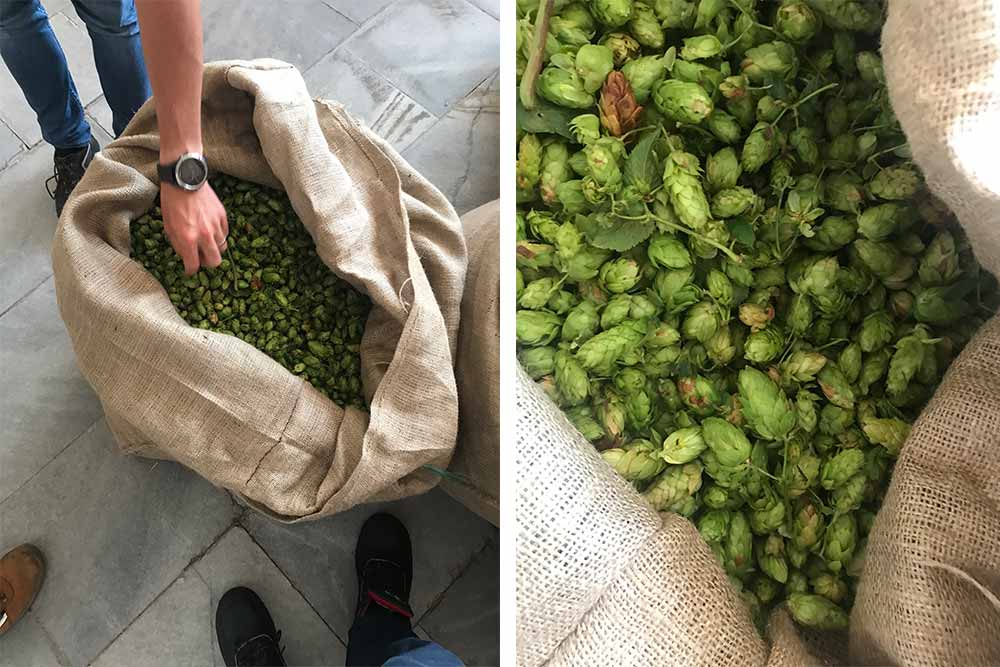
Lately, we’ve written extensively about the benefits of brewing old-world classic beers—doppelbock, Festbier, English special bitter, and the wildly popular style Czech Pilsner, among others. Making those classic brews presents an opportunity to use hops from Europe, including England and Germany. With this piece, we’ll add the Czech Republic to that list, covering the classic Czech hop, Saaz.
We went straight to the source to gather our knowledge on Saaz, chatting with experts from Top Hop and Bohemia Hop, as well as Budvar Brewmaster Adam Brož—the tenth brewmaster in the brewery’s one-hundred-and-thirty-plus-year history—to learn about the hop’s history, its characteristics, and how exactly to use it while brewing.
(Above photography courtesy of Bohemia Hop)
Affordable, Industry-Leading Brewery Software
What Are the Analytics and Ancestry of Czech Saaz?

Photography courtesy of Bohemia Hop
Saaz hops have been around for more than one thousand years, grown mainly in the Northwestern Bohemian region in the Czech Republic. But it wasn’t until the 1930s and 1940s, when Dr. Karel Osvald tried to scientifically breed the hop, that it became the crop brewers know today.
“Dr. Karel Osvald is the father of what we call Saaz hops today,” says Top Hop Sales and Quality Manager Adam Janata, explaining that Osvald, “through series of positive selections and dedicated breeding efforts in Deštnice, a small village near Saaz town, gave birth to a hop variety that later became known as Saaz.”
Janata explains that during World War II, in what was then an occupied Czechoslovakia, Osvald had to hide his plants.
“Various sources claim that he kept moving his plants around the region during the cover of dark nights in order to protect them from being stolen or destroyed by the occupying forces,” Janata says.
Janata adds that, since the Second World War, there have been many attempts to grow Saaz around the world, only to discover that the aroma, quality, and character of the same plant differed from the one grown in the Czech Republic.
“True Saaz only comes from the Czech Republic,” Janata says. “After all, nobody can cheat the terroir, right?”
Bohemia Hop Sales Manager Jan Podsednik says that, since Osvald’s breeding, there have been three clones of the hop within the country.
“Each clone is grown in different locations,” says Podsednik, noting that Bohemia grows in different regions. “Currently, hops can be grown in three regions: the Saaz region—the largest—the Auscha region in the Bohemian part of our country, and the Tirschitz region in the Moravian part.”
The state authorities strictly supervise hop growing and processing. Janata says that Czech governments have always been well aware of the value of the nation’s hops, which is why a robust system is in place to monitor and guarantee the origin and purity of Saaz and other Czech hops.
“This means that every farm, every bale of harvested hops, and every pallet or box of final product—the T90/T45 pellets—is monitored and uniquely labeled with an original ‘barcode’ by the Central Institute for Supervising and Testing in Agriculture,” Janata says. “Thanks to this, there is a perfect overview of the whole production process, and all hops from the Czech Republic come with a mandatory Variety Certificate.”
Janata adds, “So only if your hops supplier can provide an authentic Variety Certificate are they selling you a true Czech hop.”
Podsednik says that the three clone hops are registered in the Czech Republic as Saaz hops, and all registered hops range from two to five percent alpha acids.
“Younger plants have a larger alpha acid but [produce] lower yield,” Podsednik says. “Production time starts two years after [they’re] grown.”
Beta acids for Saaz tend to be a tick higher than alpha acids, though the ratio is very close—about 0.7 to 1 percent.
Brož explains, “Beta acids are about 3.5 to 5 percent, and there are 0.2 to 0.8g per 100g of total oils.
“Saaz is unique also because the beta-Farnesene content reaches ten to twenty-five percent,” Brož says. “The total polyphenols content varies between five and a half to seven percent.”
What Characteristics Shine Through with Czech Saaz?

Graphic courtesy of Bohemia Hop
Janata says Saaz’s primary asset is a balanced character, making it perfect for lagers.
“It isn’t a coincidence that pilsner-type beer became a world beer style,” Janata says. “And one of the key elements, if not the most important one, is Saaz hops.”
He credits the hops for delivering a “fine equilibrium” between many characteristics. Janata says Saaz doesn’t deliver punchiness like many American hops, but more of a sophisticated, aristocratic quality.
Top Hop Production Director Monika Boublilkova adds that what Janata describes actually comes down to an ideal composition of hop resins, essential oils, polyphenols, and a low cohumulone content.
“All of these factors blended together give beers that use this hop a more pleasant bitterness and, most importantly, an excellent drinkability that is absolutely unparalleled,” says Boublilkova, whom Janata calls “the mastermind of hops selection and purchases at Top Hop.”
“That’s why we really consider Saaz a créme de la créme among hop varieties, a Rolls-Royce, so to speak,” says Boublilkova.
Brož, who mentions that Budvar uses 300 tons of Saaz a year, says the hop brings very mild bitterness and a full hoppy aroma into the final beer.
“The aroma is mostly herbal, slightly floral with only a scent of fruits, very mild and harmonic,” he says, mentioning that the ratio of alpha- and beta-acids creates a mild to medium bitterness. “The essential oils with relatively high beta-Farnesene content lead to a unique harmonic sensorial profile.”
Podsednik says that Saaz lends a mostly herbal profile with some citrusy notes. While the aroma profile changes depending on the region, he says the differences are more or less the same.
“If you take samples, you can smell differences,” Podsednik says. “It’s interesting when brewers from the U.S. and Canada can smell so many different things.”
Weather and terroir play a factor in the profile, Podsednik notes.
“This year, we recorded a high alpha in the river. Higher temps at the higher altitudes resulted in lower alphas,” Podsednik says. “It’s a natural product. It’s always different [year to year].”
When in the Brew Process Is Best to Use Czech Saaz?

Photography courtesy of Budvar
Brož says that Saaz is best to dose late.
“This traditional hopping enables Saaz to have the most taste profile,” he says. “If you combine Saaz with other hops, adding Saaz as the last dose into the brew makes sense to save the unique aroma.”
Brož adds, “The single-hop way showed the best experience to divide the total amount of hops into three doses.”
Podsednik says where you use Saaz really depends on the brewmaster.
“Everyone prefers a different way,” Podsednik says. “Our recommendation is if you want to use essential oils, use them ten to fifteen minutes before the end of the boil. The Czech way is to boil [at] ninety minutes, and we have three hop additions.”
Podsednik adds, “The beginning is a higher alpha hop for bittering, then we have one or two hop additions. The second is right in the middle—around forty-five to fifty minutes with Sladek or similar variety—then Saaz at the end of the boil. Or you can use it in the whirlpool. It’s not the traditional way to hop the beer in the Czech Republic, though adding it there is very good.”
Is Czech Saaz Good for a Single-Hop Beer?

Photography courtesy of Budvar
Podsednik says it could work both ways, for sure. In the Czech Republic, Podsednik says brewers combine it with other bitter hops, but the usage of Saaz depends on IBU count.
“Our experience is, if you brew the beer with below thirty IBU, it’s no problem to brew with [only] Saaz,” says Podsednik, who references a brewery that made a single-hop Saaz beer using whole-leaf hops that clocked in with around twenty-four IBUs. “Anything above thirty IBUs, use something else for bittering. Getting more IBUs using Saaz is very expensive.”
Brož points to Budvar as a prime example of a beer using one hundred percent Saaz hops.
“The result of Saaz use is a drinkability of beer,” Brož says. “Budvar targets twenty-two IBU in the final beer, so for this medium-intensity bitterness, you add a lot of oils creating the aroma and a lot of polyphenols creating the body of beer if you go in a single-hop way.”
Brož adds, “On the other hand, you can freely combine Saaz with the first doses of any other Saazer varieties to reach higher bitterness. Using only Saaz for beers more bitter than approximately twenty-seven IBU could not be effective.”
But as brewers try to find ways to fit Saaz into their budget, going with a complementary hop might be the better way to go.
“Realistically, not many breweries today will be willing to pay such a premium to brew their lagers using Saaz only,” Janata says. “That’s why it is very common to use other bitter varieties, such as the Sladek, another notable Czech variety, for the first hopping, and Saaz at the end, just like a final touch of seasoning.”
Janata says that the cost of the Saaz hop—regarded as a premium variety—is relatively high, though he didn’t give the exact figure. But he views it as worth the cost.
“What can bring brewers’ budgets down—figuratively speaking—is the drinkability,” Janata says. ”Saaz helps brewers make such a beer, speaking of lager, which the consumer wants to drink more and more. So while the initial cost might be higher, the trade-off is higher consumption of the product.”
Janata explains, “As much as I enjoy IPAs and other craft beer styles, I’m never able to drink more than two to three glasses due to the very strong taste, aroma, and alcohol content, which eventually becomes too much for my sensory system. In comparison to that, I can have six or seven Czech lagers in an evening without a blink of an eye, because the taste, aroma, and alcohol content are so balanced that after the first glass, my appetite keeps only growing, and the stopping point is me becoming too drunk.”
Which Style of Beer Works Best with Czech Saaz?

Podsednik says a Bohemia-style lager is the best way to showcase the Saaz hop.
“If you want to brew the premium brand of Czech lager, use Saaz hops,” Podsednik says. “Saaz is best for bottom-fermenting beer like Bohemian, Belgian, or German lagers. You can use it in upper fermenting beer, but you can have better ways to use it.”
Brož says the Czech or Bohemian-style lager fits best with Saaz.
“The full body of the Czech lagers and the use of only pale malt, which does not mask any taste of ingredients, prepares the most suitable conditions for Saaz to be fully expressed,” Brož says.
Janata simply says that pilsner is the best: “The timeless classic style conquered the world.”



